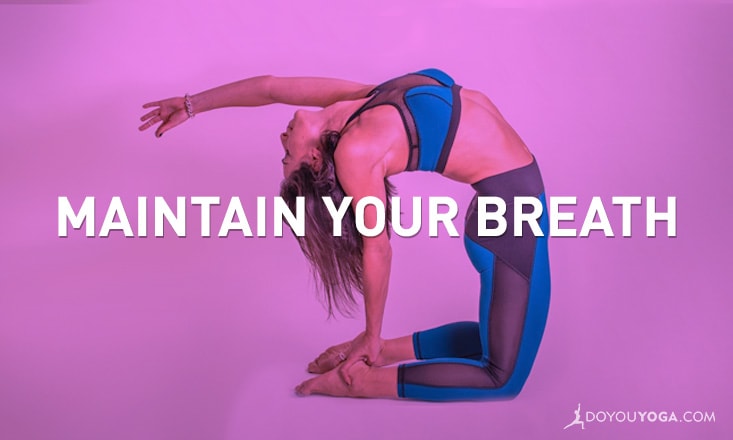While slow and deep breathing is often associated with yoga, it can be difficult and even frustrating to try and breathe slowly when moving quickly from one asana to another. While it is easy to notice the body laboring when every breath is rapid, the body also indicates it is working in overdrive when there is a need for a quick breath between long breaths. The importance of slowing down the breath can be seen in nature. For instance, slow breath rate animals such as elephants and tortoises have longer lifespans than fast breath rate animals like birds and rabbits. In addition, breathing quickly during fast-paced movements is helpful for short bursts of work but hinders the ability to sustain long term practice.
How can you maintain your breath in a fast-paced practice?
Since rapid breathing can lead to lightheadedness, hyperventilation and feelings of anxiety, it is crucial to maintain a steady and relaxed breath cycle during a fast-paced practice. Here are five key points to help maintain your breath in a fast-paced practice:
1. Relax to Extend the Breath
Tension can lead to erratic breathing patterns that hinder respiratory flow. When there are already a million things to focus on, like where to place your foot or evenly distributing weight, it can be a challenge to stay relaxed during yoga. It is especially challenging for newer yogis or even seasoned practitioners when the speed of the class increases. However, the ability to keep calm even when the practice is speeding up is essential for the lungs to work properly and not go into overdrive with slow and deep breaths. When the lungs are in overdrive, often they compensate with shallow and rapid breaths. The shallow breaths are an inefficient use of the lungs ability to obtain oxygen from the environment and expel carbon dioxide (CO2) from the body. Fun fact: the body’s respiratory flow is propelled first by the need to expel CO2 rather than to obtain oxygen.
2. Create Space for Diaphragmatic Breathing
Slumping the shoulders and hunching the back makes it harder for the lungs to reach full capacity and the diaphragm to work properly. Having the spine lengthened and the chest and belly open for breathing is ideal. However, some yoga asanas, like forward folds, compress the respiratory space. It is important in these movements to keep focus on the breath and use as much space as possible. In addition, it is often culturally conditioned for breathing to take up less space. Babies tend to breath with their bellies rising and falling with each breath, while adults are often concerned with their waistline so breath from the chest in shallow breaths. Shallow breathing is also associated with neck and shoulder tension and activation of the body’s stress response.
3. Find Your Pace
While the ego may kick in and try to convince you that you must do the practice as fast as it is being taught, take a moment to notice your inner voice. Yoga teaches the importance of ahimsa, the principle of nonviolence toward all living things, including yourself. It is important to remember that you are your own best teacher. If the pace is feeling too fast for the breath, pause and rest. Sometimes to maintain the breath, the breath first needs to slow down enough to be safe for practice. When ready to continue, practice with a pace that feels right. Lungs that are working efficiently breath in more oxygen for the muscles and last longer in any practice.
4. Make the Unconscious Conscious, Specifically Kumbhaka (Breath Retention)
Breath is often considered the doorway or bridge into the unconscious and normally automatic nervous system. While it is hard to convince the heart to beat in and out at a certain cadence, the breath is a bit more attainable. The average person breathes about 15 times per minute or 21,600 times per day or 7,884,000 times per year. There are almost 8 million chances a year to make the unconscious conscious. During a fast-paced class, there is the perfect opportunity to notice the breath as it flows.
In modern classes, it is common to have cued inhalation (pooraka) and exhalation (rechaka). It is less common to hear about breath retention or kumbhaka, specifically internal breath retention (antar kumbhaka), external breath retention (bahir kumbhaka), or spontaneous breath retention (kevala kumbhaka). In a fast-paced practice, the ability to gradually develop the control for breath retention is key to breathing at points that feel comfortable rather than breathing rapidly all the time and, subsequently, increasing the heart rate.
5. Post-Practice Pranayama
Finally, the best way to maintain your breath in a fast-paced practice is to do the work outside of the fast-paced situation. Working on various pranayamas outside of a fast-paced practice helps train the body to be ready for the next practice. Pranayama is not a mere breathing exercise; it is a great tool and part of a holistic lifestyle to efficiently utilize breath to influence the flow of energy throughout the body.
While proper breathing is essential to life, it can be hard to maintain in a fast-paced world.
Breathing properly can help decrease stress and muscle tension as well as increase focus and concentration. While proper breathing is essential to life, it can be hard to maintain in a fast-paced world. Hopefully these five tips will help you maintain your breath in your next fast-paced practice! Feel free to share other ideas below.
Image Credit: Dina Ivas


